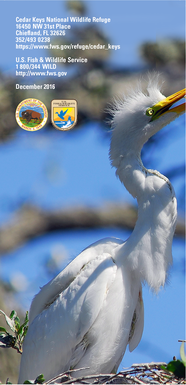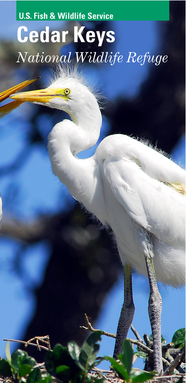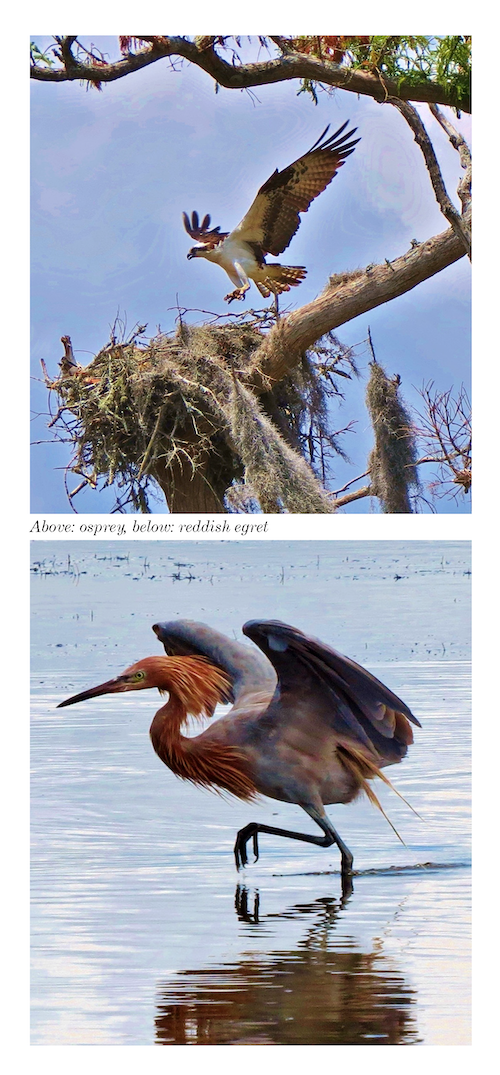Fish & Wildlife's Cedar Keys National Wildlife Refuge Brochure
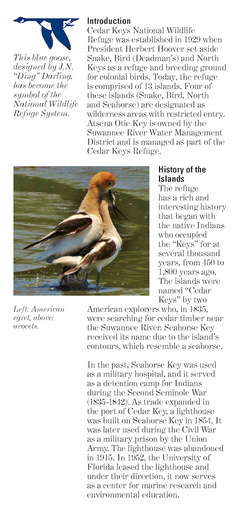
Introduction
Cedar Keys National Wildlife Refuge was established in 1929 when President Herbert Hoover set aside Snake, Bird (Deadman’s) and North Keys as a refuge and breeding ground for colonial birds. Today, the refuge is comprised of 13 islands. Four of these islands (Snake, Bird, North and Seahorse) are designated as wilderness areas with restricted entry. Atsena Otie Key is owned by the Suwannee River Water Management District and is managed as part of the Cedar Keys Refuge.
History of the Islands
The refuge has a rich and interesting history that began with the native Indians who occupied the “Keys” for at several thousand years, from 450 to 1,800 years ago. The islands were named “Cedar Keys” by two American explorers who, in 1835, were searching for cedar timber near the Suwannee River. Seahorse Key received its name due to the island’s contours, which resemble a seahorse.
In the past, Seahorse Key was used as a military hospital, and it served as a detention camp for Indians during the Second Seminole War (1835-1842). As trade expanded in the port of Cedar Key, a lighthouse was built on Seahorse Key in 1854. It was later used during the Civil War as a military prison by the Union Army. The lighthouse was abandoned in 1915. In 1952, the University of Florida leased the lighthouse and under their direction, it now serves as a center for marine research and environmental education.
Cedar Keys National Wildlife Refuge was established in 1929 when President Herbert Hoover set aside Snake, Bird (Deadman’s) and North Keys as a refuge and breeding ground for colonial birds. Today, the refuge is comprised of 13 islands. Four of these islands (Snake, Bird, North and Seahorse) are designated as wilderness areas with restricted entry. Atsena Otie Key is owned by the Suwannee River Water Management District and is managed as part of the Cedar Keys Refuge.
History of the Islands
The refuge has a rich and interesting history that began with the native Indians who occupied the “Keys” for at several thousand years, from 450 to 1,800 years ago. The islands were named “Cedar Keys” by two American explorers who, in 1835, were searching for cedar timber near the Suwannee River. Seahorse Key received its name due to the island’s contours, which resemble a seahorse.
In the past, Seahorse Key was used as a military hospital, and it served as a detention camp for Indians during the Second Seminole War (1835-1842). As trade expanded in the port of Cedar Key, a lighthouse was built on Seahorse Key in 1854. It was later used during the Civil War as a military prison by the Union Army. The lighthouse was abandoned in 1915. In 1952, the University of Florida leased the lighthouse and under their direction, it now serves as a center for marine research and environmental education.
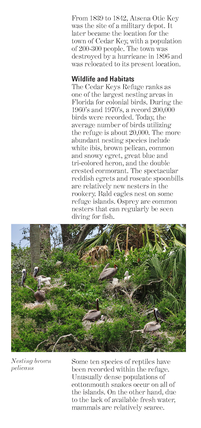
From 1839 to 1842, Atsena Otie Key was the site of a military depot. It later became the location for the town of Cedar Key, with a population of 200-300 people. The town was destroyed by a hurricane in 1896 and was relocated to its present location.
Wildlife and Habitats
The Cedar Keys Refuge ranks as one of the largest nesting areas in Florida for colonial birds. During the 1960’s and 1970’s, a record 200,000 birds were recorded. Today, the average number of birds utilizing the refuge is about 20,000. The more abundant nesting species include white ibis, brown pelican, common and snowy egret, great blue and tri-colored heron, and the double crested cormorant. The spectacular reddish egrets and roseate spoonbills are relatively new nesters in the rookery. Bald eagles nest on some refuge islands. Osprey are common nesters that can regularly be seen diving for fish.
Some ten species of reptiles have been recorded within the refuge. Unusually dense populations of cottonmouth snakes occur on all of the islands. On the other hand, due to the lack of available fresh water, mammals are relatively scarce.
Wildlife and Habitats
The Cedar Keys Refuge ranks as one of the largest nesting areas in Florida for colonial birds. During the 1960’s and 1970’s, a record 200,000 birds were recorded. Today, the average number of birds utilizing the refuge is about 20,000. The more abundant nesting species include white ibis, brown pelican, common and snowy egret, great blue and tri-colored heron, and the double crested cormorant. The spectacular reddish egrets and roseate spoonbills are relatively new nesters in the rookery. Bald eagles nest on some refuge islands. Osprey are common nesters that can regularly be seen diving for fish.
Some ten species of reptiles have been recorded within the refuge. Unusually dense populations of cottonmouth snakes occur on all of the islands. On the other hand, due to the lack of available fresh water, mammals are relatively scarce.
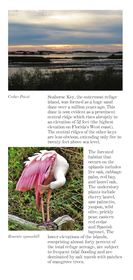
Seahorse Key, the outermost refuge island, was formed as a huge sand dune over a million years ago. This dune is now evident as a prominent central ridge which rises abruptly to an elevation of 52 feet (the highest elevation on Florida’s West coast). The central ridges of the other keys are less obvious, extending only five to twenty feet above sea level.
The forested habitat that occurs on the uplands includes live oak, cabbage palm, red bay, and laurel oak. The understory plants include cherry laurel, saw palmetto, yaupon, wild olive, prickly pear, eastern red cedar and Spanish bayonet. The lower elevations of the islands, comprising almost forty percent of the total refuge acreage, are subject to frequent tidal flooding and are dominated by salt marsh with patches of mangrove trees.
The forested habitat that occurs on the uplands includes live oak, cabbage palm, red bay, and laurel oak. The understory plants include cherry laurel, saw palmetto, yaupon, wild olive, prickly pear, eastern red cedar and Spanish bayonet. The lower elevations of the islands, comprising almost forty percent of the total refuge acreage, are subject to frequent tidal flooding and are dominated by salt marsh with patches of mangrove trees.
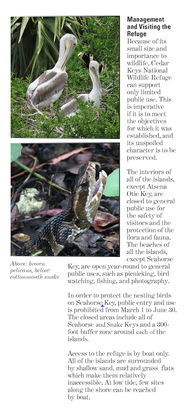
Management and Visiting the Refuge
Because of its small size and importance to wildlife, Cedar Keys National Wildlife Refuge can support only limited public use. This is imperative if it is to meet the objectives for which it was established, and its unspoiled character is to be preserved.
The interiors of all of the islands, except Atsena Otie Key, are closed to general public use for the safety of visitors and the protection of the flora and fauna. The beaches of all the islands, except Seahorse Key, are open year-round to general public uses, such as picnicking, bird watching, fishing, and photography. In order to protect the nesting birds on Seahorse Key, public entry and use is prohibited from March 1 to June 30. The closed areas include all of Seahorse and Snake Keys and a 300-foot buffer zone around each of the islands.
Access to the refuge is by boat only. All of the islands are surrounded by shallow sand, mud and grass flats which make them relatively inaccessible. At low tide, few sites along the shore can be reached by boat.
Because of its small size and importance to wildlife, Cedar Keys National Wildlife Refuge can support only limited public use. This is imperative if it is to meet the objectives for which it was established, and its unspoiled character is to be preserved.
The interiors of all of the islands, except Atsena Otie Key, are closed to general public use for the safety of visitors and the protection of the flora and fauna. The beaches of all the islands, except Seahorse Key, are open year-round to general public uses, such as picnicking, bird watching, fishing, and photography. In order to protect the nesting birds on Seahorse Key, public entry and use is prohibited from March 1 to June 30. The closed areas include all of Seahorse and Snake Keys and a 300-foot buffer zone around each of the islands.
Access to the refuge is by boat only. All of the islands are surrounded by shallow sand, mud and grass flats which make them relatively inaccessible. At low tide, few sites along the shore can be reached by boat.
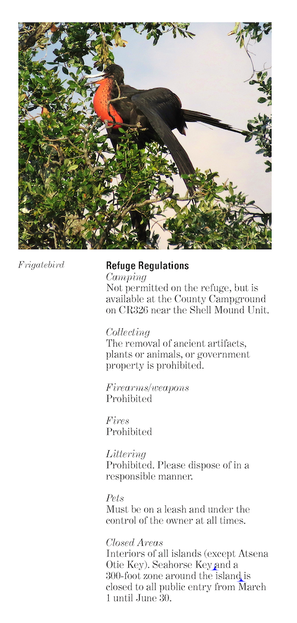
Refuge Regulations
Camping
Not permitted on the refuge, but is available at the County Campground on CR326 near the Shell Mound Unit.
Collecting
The removal of ancient artifacts, plants or animals, or government property is prohibited.
Firearms/weapons
Prohibited
Fires
Prohibited
Littering
Prohibited. Please dispose of in a responsible manner.
Pets
Must be on a leash and under the control of the owner at all times.
Closed Areas
Interiors of all islands (except Atsena Otie Key). Seahorse Key and a 300-foot zone around the island is closed to all public entry from March 1 until June 30.
Camping
Not permitted on the refuge, but is available at the County Campground on CR326 near the Shell Mound Unit.
Collecting
The removal of ancient artifacts, plants or animals, or government property is prohibited.
Firearms/weapons
Prohibited
Fires
Prohibited
Littering
Prohibited. Please dispose of in a responsible manner.
Pets
Must be on a leash and under the control of the owner at all times.
Closed Areas
Interiors of all islands (except Atsena Otie Key). Seahorse Key and a 300-foot zone around the island is closed to all public entry from March 1 until June 30.
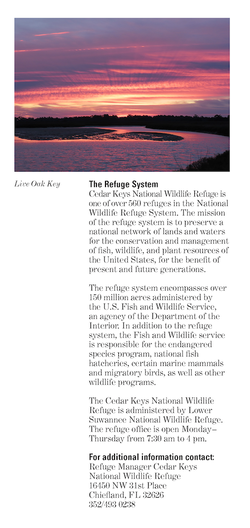
The Refuge System
Cedar Keys National Wildlife Refuge is one of over 560 refuges in the National Wildlife Refuge System. The mission of the refuge system is to preserve a national network of lands and waters for the conservation and management of fish, wildlife, and plant resources of the United States, for the benefit of present and future generations.
The refuge system encompasses over 150 million acres administered by the U.S. Fish and Wildlife Service, an agency of the Department of the Interior. In addition to the refuge system, the Fish and Wildlife service is responsible for the endangered species program, national fish hatcheries, certain marine mammals and migratory birds, as well as other wildlife programs.
The Cedar Keys National Wildlife Refuge is administered by Lower Suwannee National Wildlife Refuge. The refuge office is open Monday–Thursday from 7:30 am to 4 pm.
For additional information contact:
Refuge Manager Cedar Keys National Wildlife Refuge
16450 NW 31st Place
Chiefland, FL 32626
352/493 0238
Cedar Keys National Wildlife Refuge is one of over 560 refuges in the National Wildlife Refuge System. The mission of the refuge system is to preserve a national network of lands and waters for the conservation and management of fish, wildlife, and plant resources of the United States, for the benefit of present and future generations.
The refuge system encompasses over 150 million acres administered by the U.S. Fish and Wildlife Service, an agency of the Department of the Interior. In addition to the refuge system, the Fish and Wildlife service is responsible for the endangered species program, national fish hatcheries, certain marine mammals and migratory birds, as well as other wildlife programs.
The Cedar Keys National Wildlife Refuge is administered by Lower Suwannee National Wildlife Refuge. The refuge office is open Monday–Thursday from 7:30 am to 4 pm.
For additional information contact:
Refuge Manager Cedar Keys National Wildlife Refuge
16450 NW 31st Place
Chiefland, FL 32626
352/493 0238
